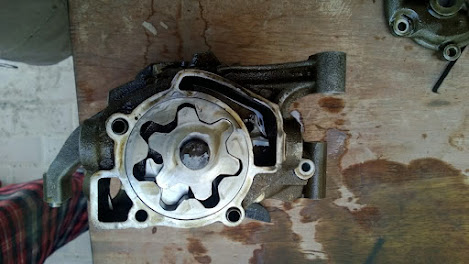Continue reading to learn more about engine oil pumps and their different types.
What Are Engine Oil Pumps?
The engine oil pump is a mechanical mechanism that circulates oil to moving parts in an engine, such as bearings, camshafts, and pistons, to prevent wear and tear. It is a critical component of an engine's lubrication system that must not fail or malfunction for the engine to work correctly.
An oil engine water pump is a centrifugal pump; an oil pump immersed in a sump can also be a centrifugal pump, and this is the most common type of lubrication oil pump for main marine engines.
How Does the Oil Pump Work?
The oil pump provides engine oil under pressure to the bearings, pistons, and camshaft. It lubricates the systems, enables the use of larger fluid bearings, and aids in engine cooling.
The oil pump is generally powered by gear from the crankshaft and begins pumping oil as soon as the engine is started.
Oil travels from a filter (where large debris is prevented from drawing)into the oil pump. The engine oil is then circulated throughout the engine's lubrication system to lubricate all active engine components.
Types of Engine Oil Pumps
Trochoid Type Oil Pump
The inner rotor is drive gear and the outer rotor, also known as the driven gear, is the two primary components of a trochoid oil pump. A casing connects the two rotors with two holes, one for oil in and one out.
The inner rotor's number of teeth is one less than the outer rotor's number of teeth. These two rotors are inserted in the casing with their centers off. The rotation of the inner rotor causes the outer rotor to rotate in the same direction.
Because the inner rotor has fewer teeth than the outer rotor, a chamber will create, which will be used to suck oil from the intake hole and press it towards the outlet hole. As the rotor revolves, the chamber volume changes, causing the oil to pump.
The Gear Type Oil Pump
The gear kind of engine oil pump was once the most frequent. It was made up of two meshing gears that rotated within a tight-fitting casing. The gears transported oil around the housing as they spun. The oil was driven into the pump by the gear teeth meshing. This gear-type oil pump delivered a steady stream of oil to the engine's numerous components.
If the flow is impeded, the oil pressure might build up to the point where the pump is damaged. If the engine oil was unusually thick, the force necessary to move the cold oil through the narrow bearing clearances might generate a similar pressure build-up, potentially destroying the pump.
Install an oil pressure relief valve was to eliminate these possibilities. When the pressure developed surpassed a predetermined value, the oil returned to the sump or the oil tank if utilised in a dry-sump system.
The Rotor Oil Pump
The rotor oil pump is a type of oil pump that is more popular than the gear type. A rotor with four or five external lobes rotates inside an outer ring (referred to as a stator) with five or six interior lobes. The inner rotor's axis was displaced from the outer ring's axis.
The result was that, despite the inner rotor driving the outer ring, the volume between the lobes changed as the two revolved. As a result, oil became trapped between the lobes and was forced out of the pump discharge tube.
In some aspects, the operation of this type of oil pump is similar to that of the rotary engine. A pressure relief valve was also required for the rotor-type oil pump.
The Rotary-Plunger Oil Pump
The rotary-plunger oil pump is a less frequent form of the oil pump. A worm gear rotated a rotary plunger, which is the only moving part. The reciprocating movement was provided by a peg engaging a profiled groove in the rotary plunger, resulting in the pumping action.
It was also essential to install a non-return valve. This type of oil pump's oil flow was irregular, and the pressure it produced was often lower than that of gear or rotor-type oil pumps. As a result, it was fundamentally unsuited for many engines.
However, it was employed in some engines that used roller or ball races as big-end or main bearings, requiring relatively minimum lubrication.
An eccentric peg on the end of a shaft, which contacted a slot in the plunger, was used to reciprocate a plunger oil pump in rare cases.
Oil could leak back through the system to the sump when the engine stopped, which was a disadvantage of both the gear and rotor-type oil pumps. As a result, neither of them was ideal for a dry-sump lubrication system that would instead use a plunger pump.
The Sliding-Vane Oil Pump
A rotor positioned eccentrically in a bore machined in the pump body makes up the sliding vane pump. Several sliding vanes, usually four, are carried by this rotor. Each vane is housed in a groove, and contact compels the vanes to retract due to the rotor's eccentric setting.
Because the vane's outside edge connects with the pump body, the pump is always divided into three chambers with varying volumes. The input port oil is pulled into the space as the vanes pass, and as the chamber shrinks, the trapped oil becomes pressured.
When a result, oil is pumped into the engine under pressure as the vanes pass the outlet port. This pump is highly efficient and has a low leakage rate, but the comparatively large number of moving parts makes it susceptible to wear.

Comments
Post a Comment